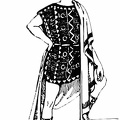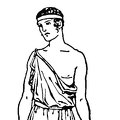The Crinkled Chiton and the Clamys (left) and the Chiton (right)
The later chiton. Approximately at the beginning of the fifth century B.C., the chiton was made on the same principle as the women's Ionic chiton using wider material; and was bound or worked at the top edge,
with the portion covering the upper arms slightly gathered. This part was buttoned or clasped back to front, and. later on sometimes sewn together, to form a sleeve. It was girded at the waist and under
the arms.
It eventually became customary to sew up the open side, thus making the garment a cylinder in shape.
The figure on left is a young man wearing a crinkled chiton under the chlamys. His long hair is twisted up and banded. He carries his petasos in his hand.
The figure on right represents a young man dressed in accordance with the fashion of the fifth century B.C., but his hair is of the sixth and fifth centuries. The lyre is a development of the more primitive instrument of an earlier Age.
- Author
- Costume and Fashion
The evolution of European dress through the earlier ages
By Herbert Norris
Published in 1924
Available at archive.org - Posted on
- Sunday 15 November 2020
- Dimensions
- 866*1380
- Tags
- Costume, Men, Place:Greece
- Albums
- Visits
- 1204
- Downloads
- 56
 Download Photo
Download Photo





